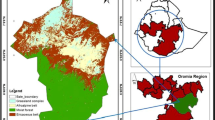Abstract
Aims
The aim was to devise a practical soil sampling design for oil palm plantations that takes into account tree-scale variability, thus facilitating detection of trends in soil properties over time.
Methods
We geometrically evaluated the ability of linear sampling transects to represent the distribution of typical management zones and radial patterns known to influence soil properties. The effect of sampling point density was tested using interpolated surfaces of soil biological, chemical and physical properties derived from values measured on a 35-point sampling grid covering the repeating tree unit in plantations with 15–25-year old palms.
Results
The ability of sampling transects to represent the proportion of the plantation in various zones improved with increasing transect length and sampling density. Increasing the number of sampling points from 10 to 50 (using an acceptably long transect with length 5.57 × palm spacing) decreased the maximum deviation between the overall mean and the transect-derived mean from 15.9 to 5.6 % for the most variable parameter, respiration, and 3.2 to 0.6 % for the least variable parameter, bulk density.
Conclusions
Transect sampling provides an efficient means of obtaining a composite soil sample that accounts for tree-scale variability in oil palm plantations. The method is readily adaptable for other tree crops.







Similar content being viewed by others
References
Arrouays D, Marchant BP, Saby NPA, Meersmans J, Orton TG, Martin MP, Bellamy PH, Lark RM, Kibblewhite M (2012) Generic issues on broad-scale soil monitoring schemes: a review. Pedosphere 22:456–469
Birkeland PW (1984) Soils and geomorphology. Oxford University Press, Oxford
Brown AJ (1999) Soil sampling and sample handling for chemical analysis. In: Peverill KI, Sparrow LA, Reuter DJ (eds) Soil analysis: an interpretation manual. CSIRO Publishing, Melbourne, pp 35–53
Comte I, Colin F, Grünberger O, Follain S, Whalen JK, Caliman J-P (2013) Landscape-scale assessment of soil response to long-term organic and mineral fertilizer application in an industrial oil palm plantation, Indonesia. Agric Ecosyst Environ 169:58–68
Corley RHV, Tinker PB (2003) The oil palm, 4th edn. Blackwell Science, Oxford
Cramb R, Curry GN (2012) Oil palm and rural livelihoods in the Asia-pacific region: an overview. Asia Pac Viewp 53:223–239
de Gruijter JJ, Brus D, Bierkens M, Knotters M (2006) Sampling for natural resource monitoring. Springer, Berlin
Goodrick I, Nelson PN, Banabas M, Wurster C, Bird MI (2015) Soil carbon balance following conversion of grassland to oil palm. Glob Change Biol Bioenergy 7:263–272
Huth NI, Banabas M, Nelson PN, Webb MJ (2014) Development of an oil palm cropping systems model: lessons learned and future directions. Environ Model Softw 62:411–419
Kuang B, Mahmood HS, Quraishi MZ, Hoogmoed WB, Mouazen AM, van Henten EJ (2012) Sensing soil properties in the laboratory, in situ, and on-line: a review. Adv Agron 114:155–223
McKenzie N, Henderson B, McDonald W (2002) Monitoring soil change. Principles and practices for Australian conditions. Technical Report 18/02. CSIRO Land and Water, CSIRO Mathematical and Information Services, National Land and Water Resources Audit, Canberra
Metcalfe D, Meir P, Aragão LEOC, da Costa A, Almeida S, Braga A, Gonçalves P, Athaydes J, Malhi Y, Williams M (2008) Sample sizes for estimating key ecosystem characteristics in a tropical terra firme rainforest. Forest Ecol Manag 255:558–566
Mitasova H, Hofierka J (1993) Interpolation by regularized spline with tension: II. Application to terrain modeling and surface geometry analysis. Math Geol 25:657–667
Mulla DJ, McBratney AB (2000) Soil spatial variability. In: Sumner ME (ed) Handbook of soil science. CRC Press LLC, Boca Raton, pp A321–A352
Nelson PN, Banabas M, Scotter DR, Webb MJ (2006) Using soil water depletion to measure spatial distribution of root activity in oil palm (Elaeis guineensis Jacq.) plantations. Plant Soil 286:109–121
Nelson PN, Banabas M, Nake S, Goodrick I, Webb MJ, Gabriel E (2014a) Soil fertility changes following conversion of grassland to oil palm. Soil Res 52:698–705
Nelson PN, Webb MJ, Banabas M, Nake S, Goodrick I, Gordon J, O’Grady D, Dubos B (2014b) Methods to account for tree-scale variation in soil- and plant-related parameters in oil palm plantations. Plant Soil 374:459–471 and erratum: Plant Soil 378:415
Pennock D, Yates T, Braidek J (2008) Soil sampling designs. In: Carter MR, Gregorich EG (eds) Soil sampling and methods of analysis, 2nd edn. CRC Press, Boca Raton, pp 1–14
Pracilio G, Adams ML, Smettem KRJ, Harper RJ (2006) Determination of spatial distribution patterns of clay and plant available potassium contents in surface soils at the farm scale using high resolution gamma ray spectrometry. Plant Soil 282:67–82
Rankine IR, Fairhurst TH (1998) Field handbook. Oil palm series volume 3. Mature. Potash & Phosphate Institute, Potash & Phosphate Institute of Canada and 4 T Consultants, Singapore
Rayment GE, Lyons DJ (2011) Soil chemical methods: Australasia. CSIRO Publishing, Collingwood
Sayer J, Ghazoul J, Nelson PN, Boedhihartono AK (2012) Oil palm expansion transforms tropical landscapes and livelihoods. Global Food Secur 1:114–119
Tinker PBH (1960) Soil heterogeneity and sampling procedure under oil palms. J West Afr Inst Oil Palm Res 4:7–15
Viscarra Rossel RA, Walvoort DJJ, McBratney AB, Janik LJ, Skjemstad JO (2006) Visible, near infrared, mid infrared or combined diffuse reflectance spectroscopy for simultaneous assessment of various soil properties. Geoderma 131:59–75
Acknowledgments
This work was funded by the Australian Centre for International Agricultural Research (Project SMCN-2009-013). We are grateful to staff of the Papua New Guinea Oil Palm Research Association for help with sampling and to Martha Karafir for help with soil analysis. We are also grateful for comments made by several reviewers, in particular Neil McKenzie.
Compliance with Ethical Standards
The authors declare that we have no potential conflicts of interest and that the research did not involve human participants or animals.
Author information
Authors and Affiliations
Corresponding author
Additional information
Responsible Editor: Zucong Cai.
Rights and permissions
About this article
Cite this article
Nelson, P.N., Banabas, M., Goodrick, I. et al. Soil sampling in oil palm plantations: a practical design that accounts for lateral variability at the tree scale. Plant Soil 394, 421–429 (2015). https://doi.org/10.1007/s11104-015-2490-9
Received:
Accepted:
Published:
Issue Date:
DOI: https://doi.org/10.1007/s11104-015-2490-9




